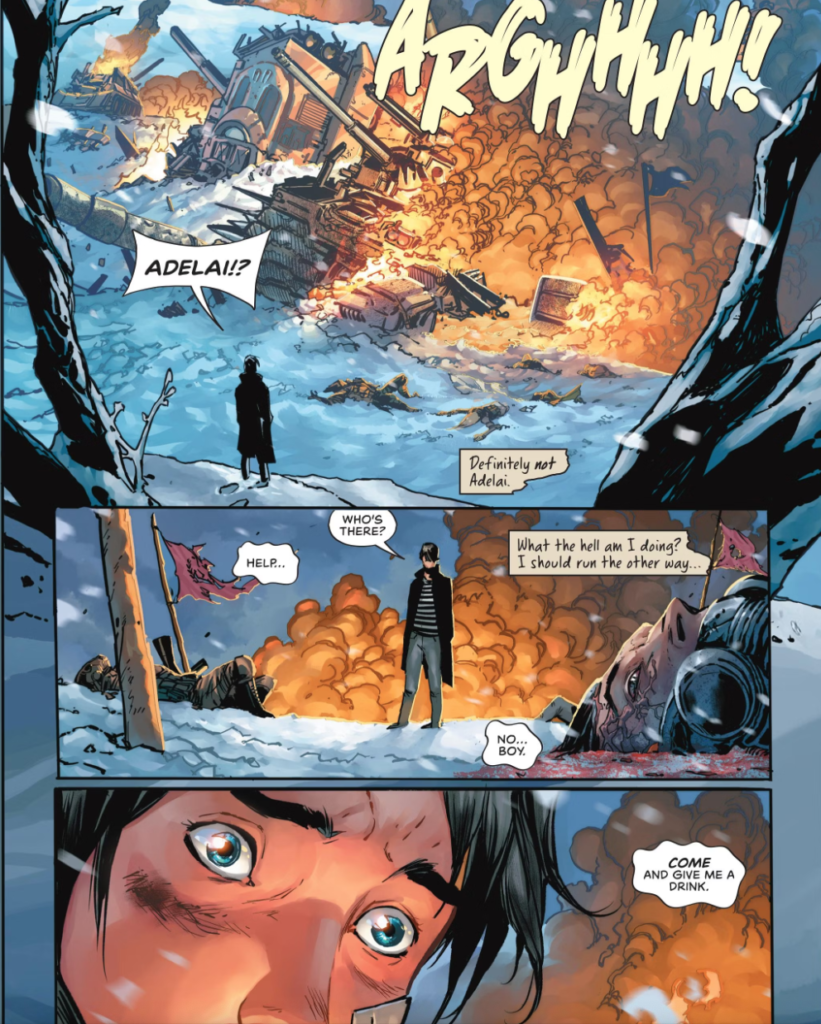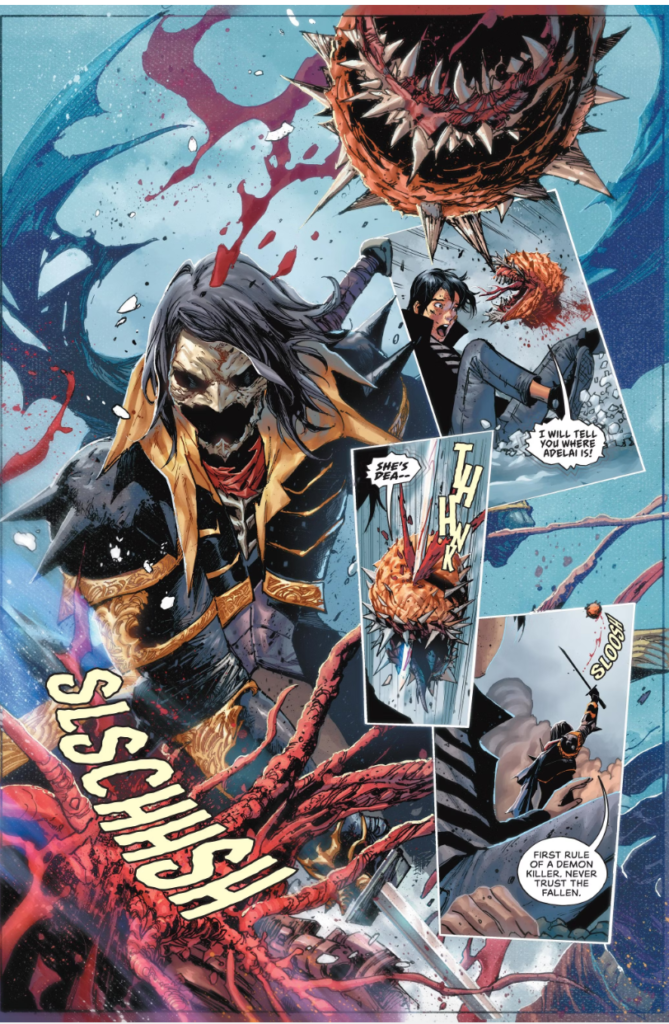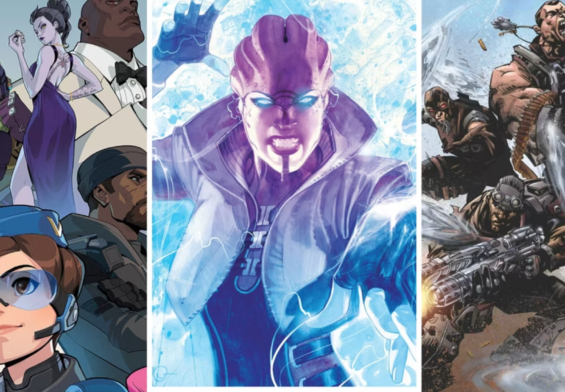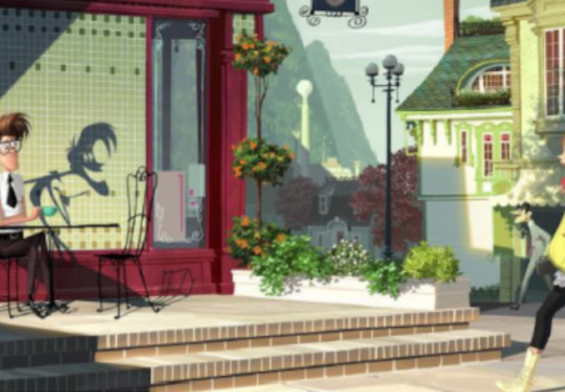How did you come up with the concept of a raging war between demons and witches that swallows the United States whole? Is this something you have always wanted to bring to life?
I’ve always had a fascination with the First and Second World Wars and the suffering that engulfs the innocents, as we’re seeing in today’s news, unfortunately. But I have wanted to do a soldier’s story for quite some time. But also, I wanted to [do] sort of a coming-of-age type of story where young, ordinary people are thrust into this huge, crazy world and grow up within it, becoming whatever they need to in order to survive. It is a very big, ambitious [story] that I think is often scary and bleak but sometimes a bit touching and romantic. So, I wanted to create a landscape that would allow me to take advantage of the vastness of the story and its characters who try to keep their humanity in inhuman conditions.

The book is packed with a ton of characters who have been affected by war. Were there any real-life inspirations behind the politically charged nature of the tale?
Nothing inspired by real life, I’m thankful to say. But in terms of how the war affects children, teens, adults, and old people alike, not just the soldiers themselves, we’ll see a lot of this as the story progresses as we get back into the Edenwood war zones in the coming arcs where different battles are being fought. The humanity and the inhumanity all at once is what I am exploring with this series. These kids have to cope with death on a daily basis and have to learn to be killers themselves to survive.
What can you tell us about Rion Astor and his mission? He starts off as the black sheep of a group of friends and becomes the dark horse by the end.
Rion is a survivor, as I reveal in the first issue, having to live on the streets after the Edenwood swallowed up his parents, leaving him orphaned and homeless. But he’s got this positivity about him that keeps him going. He’s a romantic, as we see from the start, with his girlfriend, Adelai. He’s the type to lead her to a strange and beautiful orchard of flowers called Witches’ Bloom to have a picnic. The type to find her lost dog in the woods that are a bit too close to the Edenwood, where no one has ever come back from alive. Rion puts his own life in jeopardy to find Adelai when she gets lost in the woods. He stumbles across the scene of a battle that was just recently fought where he finds his first demon. And his first demon killer. He has a path to choose. Look endlessly for Adelai and die. Or become a demon killer’s squire and also, perhaps, die. Edenwood is filled with many physical and metaphorical paths the characters have to choose from. The paths that Rion takes lead him to become a major player in the battles to come.

You are taking on writing and art duties for Edenwood. How does your approach to a script change when you know you’ll be drawing it?
I actually write out a loose outline about 4 or 5 pages long, and from there, break them down into single pages. I know, as an artist, how much I can comfortably fit on a page, so I have a bit of an advantage in writing myself. A lot of writers don’t visualize when they write and often put too much on the page. A page should comfortably fit 5, or maybe 6, panels tops. But, oftentimes, as an artist, we’ll get 8-12 actions for a page, and we have to edit it down and hope the writer can make it work. Since I’m drawing this and writing it, I see these tough decisions. And I have to cut some things sometimes. Otherwise, I myself will be running 4-6 pages over. And it’s just not ideal for the team to have to take on another 2 days or a week of work because I really needed this panel or that panel. So, it’s important to be able to have the discipline to self-edit and make the scenes work within 20-22 pages.
As for dialogue, I try to write either in the borders on the pages, or on my laptop, any ideas for dialogue as I go. I always know what’s being said on every page, but sometimes a great line will come to me, and I quickly write it down because I guarantee I’ll almost always forget it later.
The artwork goes from serene to gorer in the flick of a switch. How did you manage to balance the two for your storytelling purposes?
I think that’s the fun part, and if I can pace the scenes right, I’ll have that flip switched on an even-numbered page. So, when you flip page 7, for instance, page 8 will be the shocker image. I love the quiet scenes in this series as much as the intensely crazy scenes.

How did you find your colorists?
Nocterra ran a few months longer than I planned for, so I had to move fast if I was going to make this book happen in 2023. So fast that I had yet to find the most important creative partner for this series. As I’m a writer and artist, the colorist is really an integral piece that I rely on to get my characters, scenes, and moods across appropriately. After a few false starts (I had three different colorists at different times, set to be the colorist, all great but not the right fit), I found Jay David Ramos, who did an amazing job with the first issue. But incredible as Jay is, he had other commitments that would have affected his availability on Issues #2-3. Luckily, I finally found my permanent collaborator in Leonardo Paciarotti, who takes over in Issue #2. He is truly amazing and really making his mark. I rank Leonardo as one of the best I’ve worked with, and that says a lot, considering I’ve worked with Tomeu Morey for almost all of my DC tenure with the Batman books.
You must be excited about the fan response to your opening issue of Edenwood #1. Can you give them a glimpse into what lies ahead in Edenwood‘s future?
I am very excited by the fan response and the responses from peers and other creators [to] whom I sent the first two issues. Everyone is loving the art and the colors. They haven’t seen me go nuts like this in quite some time. But for me, most importantly, they are loving the world I am creating and the characters, the writing. That is the part I am most excited about and showing the community at large, who have yet to read anything from me.
I took a break from writing comics after Deathstroke. I instead turned to screenplay writing, where I made some great creative professional connections who have taught me things along [the] way. So, I’m always eager to be open to learning with writing, as I am with art after all these years. In terms of Edenwood‘s future, I’d say look at the first arc as a slow burn toward the much larger story that unfolds in the 2nd arc. There’s sort of a The Lord of the Rings trilogy structure that someone pointed out recently where I’m planning three giant story arcs that revolve around a gathering of allies. But even after that, the world is so big. I can keep expanding as long as there are more demons to kill. I hope this series can last many years, as it has the potential to keep going and going. I am having the time of my life, and I think it is translating into the books!








